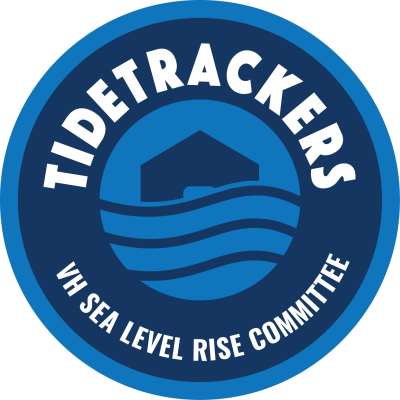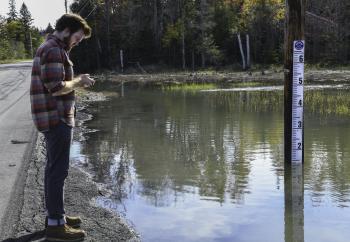TideTrackers
TideTrackers in the News
TideTrackers is featured in the Maine Monitor's Unstoppable Ocean climate change series – "Vinalhaven: Changing tides and changing minds".
What is TideTrackers?
Background
![]()
With the assistance of Knox County EMA, the Committee chose 16 “vulnerable locations” around the island, which were particularly susceptible to the impacts of coastal flooding. GPS Coordinates were calculated by visiting each site with a GPS tracker, and the coordinates were then mapped to generate an initial “Vulnerable Locations Map”. The 16 sites were then narrowed down to 7, which were either most safe to access and/or associated with critical infrastructure (e.g. roads, ferry), and this new map of the 7 locations was created. Click Here to view or download a PDF version of the map.
**Mean High Water – the average of all the high water heights observed over the national Tidal Datum Epoch (currently 1983-2001) NOAA Tides and Currents
 The Committee decided that installing an upright staff gauge (see pic to left) at each site would enable consistent water height measurements. Using a staff gauge prototype based on North Carolina King Tides Project water level gauges, Committee members constructed 10-foot gauges using 1x6-inch Azek pvc boards, and adhering a printed vinyl decal to the board that provided a “ruler”, marked in one-inch increments, by which to measure water levels up to six feet above MHW. On Vinalhaven, MHW is estimated at 9.6 feet– the “zero point”, which would indicate the height at which the gauges would be installed. Before the gauges could be installed, the MHW level for each site had to be identified.
The Committee decided that installing an upright staff gauge (see pic to left) at each site would enable consistent water height measurements. Using a staff gauge prototype based on North Carolina King Tides Project water level gauges, Committee members constructed 10-foot gauges using 1x6-inch Azek pvc boards, and adhering a printed vinyl decal to the board that provided a “ruler”, marked in one-inch increments, by which to measure water levels up to six feet above MHW. On Vinalhaven, MHW is estimated at 9.6 feet– the “zero point”, which would indicate the height at which the gauges would be installed. Before the gauges could be installed, the MHW level for each site had to be identified.

